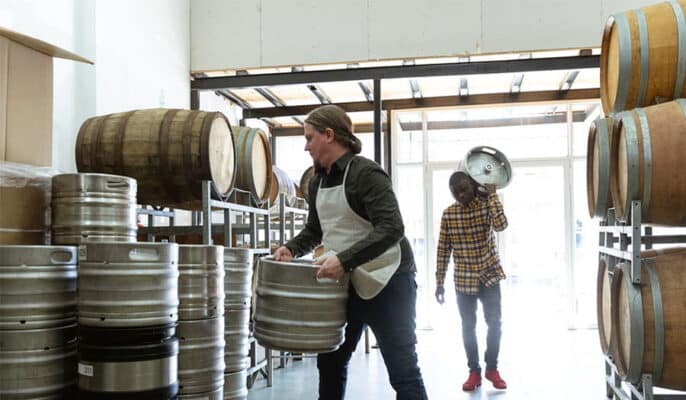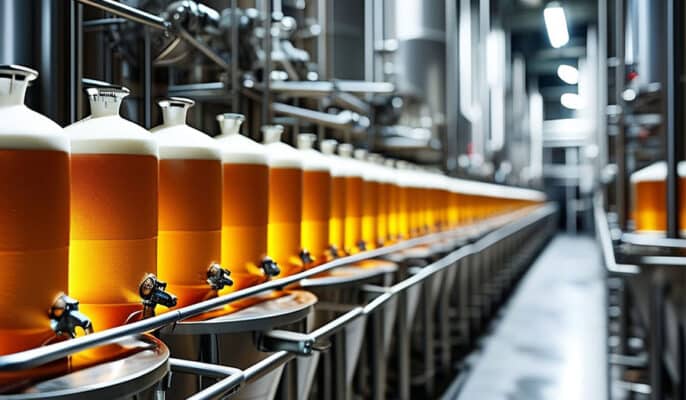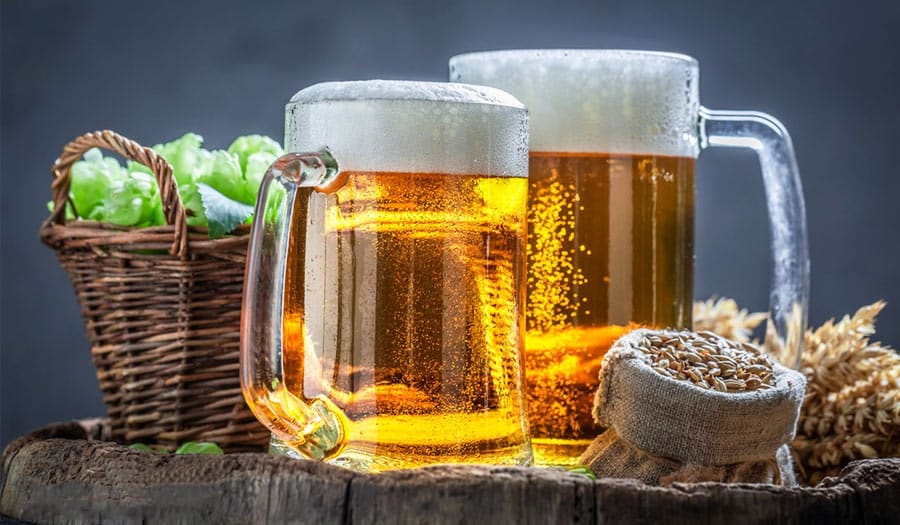Beer brewing is a complex and delicate process involving multiple steps, each of which is crucial to the flavor, taste, and quality of the final beer. This guide will explore each step of beer brewing in detail, including malt preparation, mashing, boiling, fermentation, maturation, and packaging. Each step is a key link to ensure beer quality and a full understanding of the beer brewing process.
Learn about beer brewing
Understanding beer brewing involves mastering its core steps and technical details. The basic beer ingredients include malt, hops, yeast, and water. First, the malt, which has been germinated and dried, provides sugar and flavor for beer. Then, during the mash process, the starch in the malt is converted into fermentable sugar. Hops are added during the boiling stage to give the beer bitterness and aroma. During the fermentation stage, yeast converts sugar into alcohol and carbon dioxide. Finally, the beer is matured at low temperatures to enhance the flavor. Understanding the details of each step will help you master the brewing process and create the ideal beer flavor.

Raw material selection
Malt
The first step in beer production is malting. Malt contains a range of carbohydrates, including insoluble cellulose and soluble hemicellulose, dextrins, starch, and sugars. Starch accounts for about 50% to 60% of the weight of malt. To harvest starch and convert it into sugars, barley goes through a process called malting. The barley is soaked in water and the “germ” part of the seed begins to grow into a terminal bud, i.e., germinate. After germination, the malt is dried to prevent further germination and increase its flavor and aroma. Depending on the style and needs of the beer, the type and treatment of malt can vary, such as light malt and dark malt giving the beer different colors and flavors.
Hops
Hops are cone-shaped flowers that provide aroma and bitterness to beer. The bitterness in hops balances the sweetness of the maltose and leaves a refreshing aftertaste. They can also be used as a preservative due to their antimicrobial properties. Although there are hundreds of varieties of hops, they are roughly divided into three types: bittering hops, aromatic hops, and dual-purpose hops. Their purpose is clear in the name. Different types of hops are added at different stages of the boil to create a more complex hop profile, giving the beer a good balance of flavor, aroma, and bitterness.
Yeast
Yeast management is key to brewery fermentation efficiency and final beer quality. Important steps to maintain the vitality and viability of cultured yeast are proper pitching and pruning of yeast, propagation of yeast from the lab to full-scale pitching, storage of yeast for reuse, and the use of acid-washing yeast techniques to reduce infection. There are two main types of yeast: Ale Yeast and Lager Yeast. Top-fermenting yeasts are usually fermented at higher temperatures and produce more fruity and ester aromas, while bottom-fermenting yeasts are fermented at lower temperatures and produce cleaner, lighter flavors.
Important steps in beer brewing
Malt
The first step in beer production is germination. Fresh barley is first soaked in water and then placed in so-called germination boxes for germination. At this stage, enzymes (amylases) are formed that are necessary for the separation of starch. The germination process is then interrupted at the optimal stage by drying (kilning). The green malt is carefully dried at 80° Celsius and tastes slightly sweet after drying. The maltose is then used to feed the yeast culture and then form alcohol.
Milling
The second step in the brewing process is grinding. The finished malt is ground, similar to making flour so that it dissolves better in water. Malt mills produce various grades of ground malt: husks, husks, semolina, and grist (from the coarsest to the finest).
Mashing
The mashing process involves adding the malted grains to hot water. During the soaking of the malt, the hot water activates enzymes that break down the starch and release simple sugars. After soaking, the mixture forms a viscous substance that looks like porridge. This process can take anywhere from 30 to 120 minutes or even longer, depending on the temperature and the type of enzymes. The solids are then separated from the sweet water, which is called wort.
Filtering and Boiling
After mashing, the wort needs to be separated from the malt residue. This process is called Lautering. The wort is then passed through a filter, which is usually made of malt husks or other materials to ensure effective separation of the malt residue. The resulting wort is poured into a boiling kettle and heated to a boil. The boiling process not only kills potential microorganisms but also releases the bitter substances in the hops. Hops are often added at different stages of the boil to achieve different flavor effects.
Cooling and Fermentation
After the boil is completed, the wort is quickly cooled to avoid bacterial contamination is ready for fermentation, and is transferred to a fermentation vessel. Yeast is then added to the cooled wort, and the “magic” of brewing begins. Over the next few days, the yeast consumes the sugars in the wort, producing carbon dioxide and alcohol. The duration of fermentation varies depending on the type of beer, but it usually does not exceed two weeks.
Carbonation and Maturation
When the fermentation process is deemed complete, the conditioning or maturation process can begin. At this point, the yeast will calm down and absorb some of the unwanted compounds, such as carbon dioxide and ethanol. The yeast will then settle and be separated from the beer along with other unwanted sediment. Carbonation occurs after beer is filtered, but secondary fermented beer does not need to be carbonated. Carbonation has a significant impact on the mouthfeel, flavor, aroma, and appearance of the beer.

Beer Brewing System
Extraction Brewing System
Extract Brewing is a convenient and efficient way to brew for beginners or those with limited time and space. This system mainly uses pre-made malt extract (liquid or dry powder) to simplify the mashing process. The extraction brewing system works by mixing the malt extract with hot water, boiling it, adding hops, and then cooling and fermenting. The advantages of this method include simple operation, short time, and low equipment requirements. However, its disadvantages may limit the full control of the brewing process and cannot fully reflect the complex flavor of all-grain brewing.
All-Grain Brewing System
All-Grain Brewing is the ultimate goal pursued by serious home brewers. Unlike extraction brewing, all-grain brewing uses whole-grain malt and converts starch into sugars through the mashing process. This method provides full control over the brewing process so that the flavor and taste of the beer can be adjusted. The equipment required for all-grain brewing includes a mash tun, a filtration system, and a more complex fermentation vessel, which makes the whole process more complicated and time-consuming than extraction brewing. However, it delivers richer layers of flavor and a unique homebrew experience, making it ideal for enthusiasts looking to gain a deeper understanding and master the art of brewing.
How to choose the right beer brewing system?
- Consider your brewing goals: Before deciding which brewing system to invest in, you first need to clarify your brewing goals. Do you plan to brew beer for personal fun and enjoyment, or are you aspiring to build a commercial brewing business? Clear goals will help you choose the most suitable system and ensure that your investment and efforts will bring the expected return.
- Budget and space constraints: Your budget and available space will directly affect the brewing system you choose. First, evaluate your budget range, as different brewing systems and equipment have different costs. Beginners may tend to choose lower-priced systems with fewer equipment requirements, while higher budgets may support more complex and high-end brewing equipment. In addition, it is also crucial to consider the space required for brewing equipment, making sure you have enough space to accommodate and operate the selected system, while also considering the storage and maintenance of brewing equipment.
- Brewery experience level: Your brewing experience and skill level are crucial to choosing the right brewing system. Beginners may be more inclined to choose extraction brewing systems that are easy to operate and have a lower learning curve, while experienced brewers may pursue all-grain brewing systems that provide greater flavor control and creativity.
FAQ
What are the basic steps of beer brewing?
- Raw material preparation: select and prepare malt, hops, yeast, and water.
- Mash: mix malt with hot water to convert starch into fermentable sugars.
- Sugar filtering: separate malt residue from mashliquid to obtain clear wort.
- Boiling: boil wort and add hops to increase bitterness and aroma.
- Cooling: quickly cool the boiled wort to a temperature suitable for fermentation.
- Fermentation: transfer the cooled wort to a fermentation container and add yeast for fermentation.
- Maturation: after fermentation is completed, the beer is matured at low temperatures to improve the flavor.
- Packaging: filter the matured beer and bottle or can it.
How to choose the right yeast?
Different styles of beer require different yeast strains. For example, Ale usually uses top-fermenting yeast, while Lager uses bottom-fermenting yeast. The optimal fermentation temperature range of yeast is different, choose the yeast that suits your brewing conditions. At the same time, the fermentation characteristics of the yeast, such as fermentation speed, flavor production, etc., must also be considered.
What is the role of the maturation stage?
The role of the maturation stage is to allow the beer to further develop its flavor at low temperatures and improve its taste. During the maturation period, the yeast and other sediments in the beer will settle to the bottom, making the beer clearer. At the same time, this stage can also balance the taste and flavor of the beer and remove unnecessary flavors.




